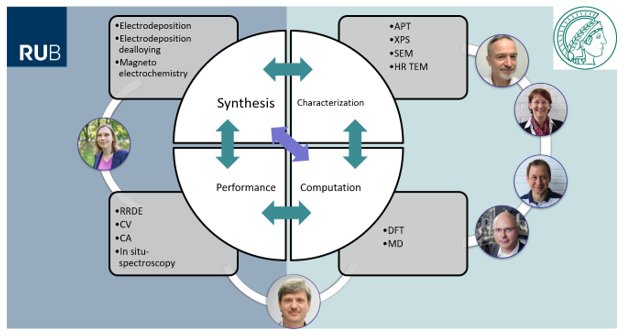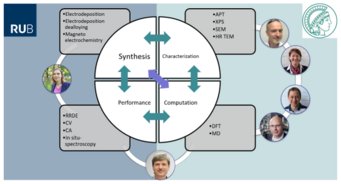
Max Planck Fellow Group
Electrochemistry and Nanoscale Materials
The development of improved electrocatalysts for renewable energy technologies and synthesis of industrially important materials are held back by the current lack of information on favorable catalysts properties. This Group aims at dissecting the influence of compositional and structural material properties to eventually overcome this issue and provide clear criteria for reaction-specific rational catalysts design. To this end, we systematically alter the relevant materials’ properties, such as composition, grain size, surface facets and porosity, and investigate their efficiency.
Our group employs new electrochemical methods to characterize reactions at or of single nanoparticles and surface-immobilized nanoparticle ensembles. We also conduct innovative synthesis and processing steps for catalyst materials, such as magnetic field-assisted electrochemical deposition and dealloying. These materials are utilized as catalysts with systematically tuned and precisely characterized properties to identify their performance in terms of electrocatalytic activity, selectivity and ageing. In addition to established electrochemical characterization of large numbers of nanoparticles immobilized on a surface, single nanoparticle electrochemistry is used to determine the intrinsic electrochemical response of individual particles. In depth ex situ characterization and operando spectroelectrochemical methods allow us to account for changes in properties, activities and selectivity during electrocatalysis. Moreover, the experimental tasks are supported by state-of-the-art computational studies to gain fundamental insights into catalyst restructuring under operando conditions and into the atomic-scale processes occurring at the solid/liquid interface. Following this joint cross-disciplinary approach, we will gain a better basic understanding of material property-activity relations, and we will identify new strategies and tools to adjust the desired properties of a material during synthesis or post-processing.
The cooperation with the MPIE extends to the areas of characterization and computation. A wide variety of investigation and modeling/ simulation methods are used, see Fig. 1.
All departments of the institute and the following research groups are involved:

- Department "Microstructure Physics and Alloy Design" (Prof. D. Raabe),
- Independent research group "Nanoanalytics and Interfaces" (Prof. C. Scheu),
- Department “Structure and Nano-/ Micromechanics of Materials” (Prof. G. Dehm) with the research groups “Advanced Transmission Electron Microscopy” (C. Liebscher), “Thin Films & Nanostructured Materials” (J. Best / H. Bishara) and “Nanomechanical Instrumentation and extreme Nanomechanics - XNano"(R. Ramachandramoorthy),
- Department “Interface Chemistry and Surface Engineering” (Prof. J. Neugebauer / M. Rohwerder)
- Department “Computational Material Design” (Prof. J. Neugebauer).
